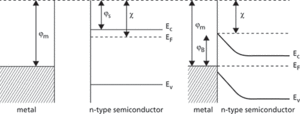A reduction in the work function of a substance when an external accelerating electric field is applied to its surface in a vacuum. The field reduces the potential energy of electrons outside the substance, distorting the potential barrier at the surface and causing field emission. A similar effect occurs when a metal surface is in contact with a semiconductor rather than a vacuum, when it is known as a Schottky barrier. The effect was discovered by the German physicist Walter Schottky (1886–1976).
A reduction in the effective work function of a solid when an external accelerating electric field, E, is applied in a vacuum to the surface. In the case of a metal, image charges (see electric images) contribute to the effect, which is therefore sometimes termed image-force lowering. The external field lowers the potential energy of electrons outside the solid with a consequent distortion of the potential barrier at the surface. Electrons just inside the surface are liberated by surmounting the barrier (in contrast to the tunnel effect). A slight increase in electron emission from a thermionic cathode results from this effect.
A similar effect is observed when the metal surface is in contact with a semiconductor. Such a metal-semiconductor contact is termed a Schottky barrier; the energy levels associated with the junction are shown in the diagram. The magnitude of the lowering of the work function depends critically upon the surface state of the semiconductor but is usually less than the vacuum case described above. Schottky barriers are used to form Schottky diodes, in Schottky TTL and Schottky I2L logic circuits, and to form the gate electrode of one type of junction field-effect transistor.

Energy diagrams before and after forming ideal Schottky barrier
- steady flow
- steady state
- steady-state approximation
- steady state landscape
- steady-state theory
- stealth technology
- stealth virus
- steam
- steam cracking
- steam cycle
- steam distillation
- steam engine
- steam fog
- steam injection
- steam jacket
- steam jet ejector
- steam point
- steam power
- steam reforming
- steam tables
- steam tracing
- steam trap
- steam turbine
- stearate
- stearic acid